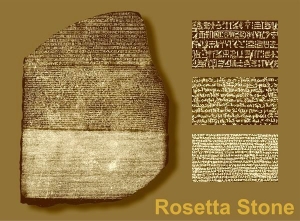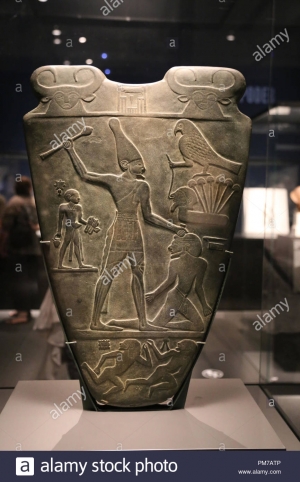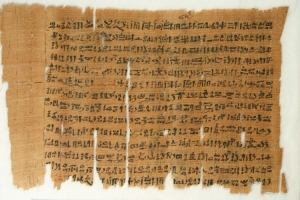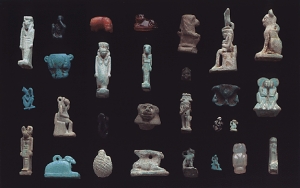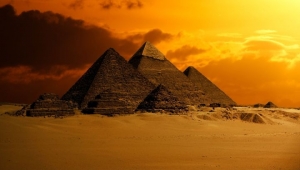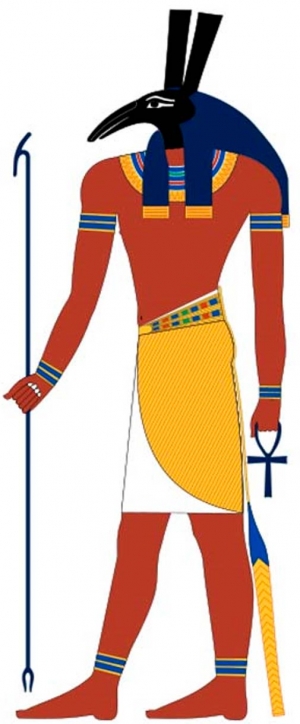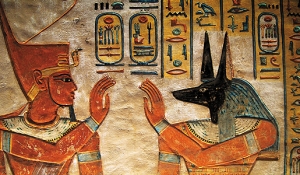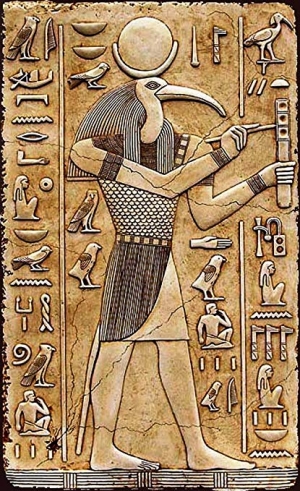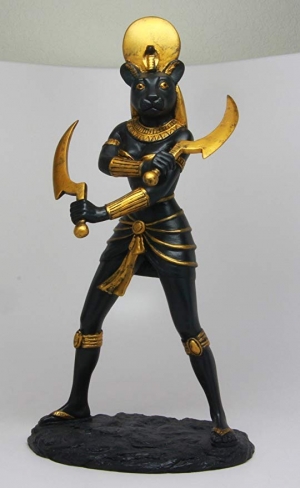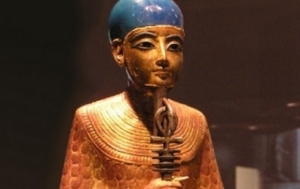+2 0122-345-3028
This email address is being protected from spambots. You need JavaScript enabled to view it.
Super User
Text of the Rosetta Stone
Text on the Rosetta Stone
- During the reign of the young and after he succeeded the kingship from his father, the lord of diadems, most glorious, who established Egypt and who is pious prior the gods.
- He who triumphed over his enemies, who fixed the civilised lifetime of men, lord of the Thirty Years Festivals, as exactly did Hephaistos the good, he who is additionally a king a small amount just like the Sun,
- Great king of the Upper and Lower countries, offspring of the Gods who give honours to their ancestors, one altogether whom Hephaistos has approved, to whom the Sun has given victory, the living image of Dias, son of the Sun,
- Living for ever, Ptolemy, beloved of Ptah, within the ninth year, when Aetos son of Aetos was priest of Alexander, and of the saviour Gods, and of the brother Gods, and of the benefactor Gods, and of the Gods who give honour to the ancestors, and
- when the illustrious God was happy; you who transport the deeds of Vereniki the benefactor, Pyrrha daughter of Philinos; Areia daughter of Diogenes you're the one who carry the basket of Arsinoe Philadelfos.
- Irine, Ptolemy daughter, Priestess of Arsinoe Philopator; the 4th of the month named Xandikos, keep with the Egyptians the 18th Mekhir. DECREE. The High Priests and Prophets made an assembly and then people who entered the inner shrine to position ornaments for the Gods,
- among with the Feather - bearers and thus the Sacred Scribes and everyone the opposite priests from the temples throughout the land who have come to fulfil the king at Memphis, for the case of the feast of the thought
- by Ptolemy, the ever living, the beloved of Ptah, the God Epiphanes happy, who succeeded his father to the kingship. All of them were assembled within the sacred temple in Memphis now declared:
- The king Ptolemy, the ever living, the beloved of Ptah, the god Epiphanes Happy, the son of King Ptolemy and Queen Arsinoe, the Gods Philopatores, has been a benefactor both to the temples and
- to people who dwell in them, also to people who are his subjects, who exists as a god sprung from a god and goddess being benevolently disposed towards the gods,
- has dedicated to the temples money and corn and has undertaken much outlay to bring Egypt into prosperity, and to figure out the temples,
- has been generous with all his own means; and of the income and taxes levied in Egypt some he has wholly remitted et al he has lightened, so as that the people and everybody the others could even be
- in prosperity during his reign; and whereas he has deleted the debts to the crown being lots in number which they owed to Egypt and to the remainder of the kingdom;
- he has freed of the costs those that were in prison and people who were under accusation for a protracted time; he directed that the gods shall still enjoy the revenues of the temples and then the yearly allowances given to them, both of
- corn and money both with the revenue assigned to the gods from vine land and from gardens and the alternative properties which belonged to the gods in his father’s time;
- he directed also, regarding the priests, that they must pay no more because the tax for admission to the priesthood than what had appointed them throughout his father’s reign; he relieved the members of the
- priestly orders from the yearly journey to Alexandria; he directed that impressment for the navy shall not use as for the tax in byssus cloth which the temples paid to the crown
- he remitted the two-thirds; he also restored to their previous condition all the items which were neglected in former times, he took care how the standard duties shall be fittingly paid to the gods.
- He apportioned justice to any or all, like Hermes the great; he ordained that people who return of the warrior class, and of others who were unfavourably
- disposed within the days of the disturbances, should, on their return be allowed to occupy their old possessions; he on condition that cavalry and infantry forces and ships should be sent out against folks that invaded
- Egypt by sea and by land, laying out great sums in money and corn so as that the temples and every one folks that are within the land could even be in safety;
- he visited Lycopolis within the Busirite nome, which had been occupied and fortified against a siege with an abundant store of weapons, (he saw that disaffection was now of long
- standing among the impious men gathered into it, who had perpetrated much damage to the temples and to any or all the inhabitants of Egypt),
- and as he encamped against it, he surrounded it with mounds and trenches and elaborate fortifications; when the Nile made an honest rise within the eighth year (of his reign), which usually floods the
- plains, he prevented it, by damming at many points the outlets of the channels, and setting cavalry and infantry to shield them,
- in an exceedingly short time he took the town by storm and destroyed all the impious men in it, while Hermes and Horus, the son of Isis and Osiris, formerly subdued the rebels within the identical district;
- and on those that had led the rebels within the time of his father and who had disturbed the land and done wrong to the temples, he came to Memphis to avenge
- His father and his own kingship, and punished all as they deserved, at the time that he came there to perform the proper ceremonies for the thought of the crown; and whereas he remitted what
- Was thanks to the crown within the temples up to his eighth year, being no touch of corn and money; so also, the fines for the byssus
- Cloth not delivered to the crown, and of these delivered, the several fees for his or her verification, for the identical period; and he also freed the temples of the artabe for each aroura of sacred land and likewise
- The jar of wine for every aroura of vine land; and whereas he bestowed many gifts upon Apis and Mnevis and upon the opposite sacred animals in Egypt, because he was way more considerate than the kings before him of all that belonged to
- The gods; and for his or her burials he gave what was suitable lavishly and splendidly, and what was regularly paid to their special shrines, with sacrifices and festivals and other customary observances;
- And he maintained the honours of the temples and of Egypt in line with the laws; and he adorned the temple of Apis with rich work, spending upon it gold and silver
- And precious stones, no small amount; and whereas he has founded temples and shrines and altars, and has repaired those requiring it, having the spirit of a beneficent god in matters regarding
- Religion; and whereas after enquiry he has been renewing the foremost honourable of the temples during his reign, as is becoming, in requital of which things the gods have given him health, victory and power, and every one other delicacies,
- And he and his children shall retain the kingship for all time. With propitious fortune: it absolutely was resolved by the priests of all the temples within the land to extend greatly these honours of
- King Ptolemy, the ever living, the beloved of Ptah, God Epiphanes Eucharistos likewise those of his parents the Gods Philopatores, and of his ancestors, the Gods Euergetai and
- The Gods Adelphoi and thus the Gods Sotires and to line up within the foremost prominent place of each temple a picture of the ever-living King Ptolemy, the beloved of Ptah, the God Epiphanes Eucharistos.
- a picture which shall be called that of Ptolemy, the defender of Egypt’, beside which shall stand the principal god of the temple, handing him the weapon of victory, all of which shall be manufactured
- fashion, which the priests shall pay homage to the pictures 3 times daily, and put upon them the sacred garments, and perform the opposite usual honours like given to the choice gods within the Egyptian
- festivals; and to figure out for King Ptolemy, the God Epiphanes Eucharistos. sprung of King Ptolemy and Queen Arsinoe, the Gods Philopatores, a statue and golden shrine in each of the
- Temples, and to line it up within the inner chamber with the opposite shrines; and within the great festivals within which the shrines are carried in procession the shrine of the God Epiphanes Eucharistos shall be carried in procession with them.
- so as that it should be easily distinguishable now and for all time, there shall be attack the shrine the ten gold diadems of the king, to which shall be added an uraeus but rather than
- The uraeus-shaped diadems which are upon the opposite shrines, within the centre of them shall be the crown called Pschent which he placed on when he went into the temple at Memphis
- To perform therein the ceremonies for assuming the kingship; and there shall be placed on the square surface round about the diadems, beside the crown, golden symbols
- That it's (the shrine) of the king who makes manifest the Upper and Lower countries. And since it's the 30th of Mesore on which the birthday of the king is widely known, and likewise
- on which he succeeded his father within the kingship, they need held nowadays in honour as name-days within the temples, since they're sources of great blessings for all; it had been further decreed that a festival shall be kept within the temples throughout Egypt
- On nowadays in each month, on which there shall be sacrifices and libations and everybody the ceremonies customary at the opposite festivals
- Serve within the temples. And a festival shall be kept for King Ptolemy, the ever living, the beloved of Ptah, the God Epiphanes Eucharistos, yearly within the temples throughout
- the land from the first of Thoth for five days, during which they shall wear garlands and perform sacrifices and libations and thus the alternative usual honours, and therefore the priests shall be called
- Priests of the God Epiphanes Eucharistos additionally to the names of the choice gods whom they serve; and his priesthood shall be entered upon all formal documents (and engraved upon the rings which they wear);
- and personal individuals shall even be allowed to stay the festival and founded the shrine and have it in their homes, performing the celebrations
- Yearly, so as that it should be known to any or all that the lads of Egypt magnify and honour the God Epiphanes Eucharistos the king, keep with the law. This decree shall be inscribed on a stela of
- Hard stone in sacred [that is hieroglyphic] and native [that is demotic] and Greek characters and founded in each of the primary, second, and third temples beside the image of the ever-living king.
Narmer palette Egyptian Museum 3200 BC
Narmer Palette Egyptian Museum 3200 BC
The founder of the first dynasty is considered according to a scientific document to be the legendary king Narmer (Menes). This view is valid according to archaeological evidence and as it proves that the ancient Egyptians already from the time of the New Kingdom inscribed in their monuments the name Mena as the first pharaoh.
Narmer's tomb was found in Abydos, he had his tomb in Abydos, the cemetery of the first pharaohs. Among other finds was a green slate palette, which is on display at the Cairo Archaeological Museum. It has scenes on both sides that commemorate the king's victory and the crushing of his enemies.
The name of the king is engraved in both sides at the top, Narmer (Nar -mr). The inscription is in a rectangular shape that identifies with the front of the palace. There is on both sides the head of the goddess Hathor in female form with cow ears and horns.
On the front and in the middle of it, the king can be seen standing upright, carrying the White Crown and holding his enemy by the head. The enemy is kneeling before the king. Its name is wcsw. The king holds in his right hand a sceptre with which he is going to crush the enemy. In front of the king is presented the figure of the god Horus as a falcon to control the enemy who is tied a rope around his nose. The enemy head is projected on a horizontal bar. Behind the enemy's head rise six papyrus-shaped stems, which support the falcon's foot. On each piece of papyrus is engraved the number 1000 in the Hieroglyphic form. This is an indication that the god Horus controlled the king's enemies and gave him 6000 prisoners. The king follows a sandal-bearer holding a vase in one hand and the king's sandals in the other.
In the last part of the front of the palette we see two enemies in a standing position.
In the middle of the back of the palette, king Narmer carries the Red Crown while his sandal-bearer follows him. In front of him is a high-ranking officer who follows four flag bearers of official emblems. To the right are two rows of enemies, each with its head cut off and its arms tied behind its back and its legs facing inwards, except for the first in each row. These are obviously the leaders of the enemies. The king therefore marches in a procession led by his officials and the banners raised in honor in an attempt to expose the bodies of the prisoners of his enemies from the north.
In the third part of the back of the palette we distinguish two animals with long necks, forming a circle in the middle of their necks. Two royal followers hold the heads of the animals with a rope.
In the last part of the palette the king in the form of a bull attacks an enemy with his horns.
These are scenes that commemorate king Narmer's victory over the North and are a celebratory representation of his supremacy.
Youth Formulas in Ancient Egyptian life
The Youth Formulas in Ancient Egyptian life
As Egyptians were looking for beautiful and having a fresh and young appearance mattered a lot.
They loved to look Healthier and younger than their age.
For this reason, ancient Egyptians used a selection of Special formula to prolong a beautiful and youthful appearance. Egyptians used various cosmetics and perfumes to make the old look young.
The Magic Of Making the Old Look Young
The way Egyptians used these various ingredients to make people look beautiful and younger seems almost like a type of magic that converted the old into young. To make a person look young they had various methods and applications for the face, hair, nails and overall appearance.
Hair
A hair usually loses its charm and softness with time. It fails to get the proper nutrients as the man or woman grows old resulting in old and brittle-looking hair. To overcome this Egyptians used henna, a dye made from natural extracts that colored hair and rejuvenated it. Apart from the use of henna, several ornaments and flowers were also used for the adornment of hair that made it look marvelous and attractive instead of old and dry.
The Face
Wrinkles, acne and blackheads are a sign of age and fading beauty. The face is the first thing we see when we take a glance at someone and hence maintaining a healthy and attractive face was seen as extremely necessary during the ancient Egyptian period. As a result, ancient Egyptians used several kinds of makeup to decorate their face and restore its beauty, including red makeup for making their lips and cheeks look beautiful and youthful.
The Eyes
Beautiful and elegant eyes are a must for a person to look young and attractive. As the age progresses, the eyes can lose their spark which takes away a youthful shine and brilliance from one's face. Egyptians used dark green and black makeup for making their eyes look broad and outlined. They used these black and green formulae of ingredients such as kohl to make the eyes sharp. This gave a young and stunning appearance to the overall face. The tiredness and rigidity in eyes were thus replaced by a lightning spark of vitality.
Fingernails & Hands
Beautiful and pretty looking hands were also very important to ancient Egyptians. They used henna of different colors like yellow-orange, green and brick red for decorating their nails and they also used it for making different kinds of tattoos on their hands. This usually varied depending on your occupation but it was common through various layers of Egyptian society.
Youthful Ancient Egypt
Ancient Egyptians used all these techniques and more to look young and beautiful. From the hair to the face and hands they had a formula for almost everything in order to prolong youthful beauty as long as possible.
Egyptian Amulets
Egyptian Amulets

As from the early cavemen time has protected himself with the use of amulets, an object imbued with mysterious and magical powers. Amulets may come and go in fashion over the years but their purpose endures. Amulets provide people with health, luck, fertility, power, success and just about any other need.
To ancient civilizations these needs were controlled by the forces of good and evil. Prayers, offerings and sacrifices were offered to the good spirits to grant blessings, amulets stopped the evil spirits from taking them away.
Originally amulets were only natural objects. But as civilizations progressed amulets were fashioned into animal shapes, symbols, seals, rings and plaques.
These items were imbued with magical powers and inscriptions of powerful spells.
The word amulet probably comes from the Latin word amuletic. Amulets with inscriptions are sometimes called charms. An amulet is worn on the body, usually around the neck, but some amulets guard homes, tombs and buildings.
Ancient Assyrians, Egyptians, Babylonians, Arabs and Hebrews placed great importance in amulets. The frog protected fertility, Ankhs for everlasting life, udjat for health, scarab for resurrection after death. Some of the Egyptian amulets are massive such as the stone beetle mounted on a pedestal at Karnak measures five feet long by three feet wide and weighs more than two tons.
The Babylonians and Syrians used cylinder seals which were imbedded with precious stones. Hebrews wore crescent moons to ward off evil. The natives of Africa carry amulets consisting of a pouch or box of medicine such as fruits, plants, vegetables, etc.
Two amulet symbols that are universal are eyes and phallic symbols. Eyes protect against evil spirits and phallic symbols against evil. In magic using the name of a deity is equivalent into tapping the divine power. In the Old Testament the Hebrews gave the personal name of God as a four-letter word called the tetragrammaton, translated as YHWH and pronounced YAHWEH. This name appeared in spellings on amulets to help magicians conjure demons and also protect from attack.
The story of The Pyramid s
The story of The Pyramid s
The Development Of The Royal Tomb In Ancient Egypt: The most famous tourist attraction in our world nowadays is the Giza pyramids in Egypt and the great pyramid of king Cheops…and here I would like to answer so many questions usually asked by the visitors of Egypt and those who are interested in knowing about the pyramids and the ancient monuments if not asked by everybody in the world when they think about the pyramids. What is the pyramid? How was the great pyramid built at the time there was no machines to help?
How many people worked for the construction of the great pyramid?
The pyramids were built by slaves, true or not?
How the process of cutting the stone was done?
These questions are just some of many questions might come up to your mind when you just see the great pyramid of Giza, even when you see just a picture of it.
Pyramids Introduction:
The pyramid in ancient Egypt was the tomb of the king, and the pyramid shape was first built by chance when the architect of one king’s tomb insisted on changing the appearance of his king’s tomb when he had the chance to do so…
The very first pyramid is the step Mastaba at Sakkara of king Djoser the founder of the 3rd dynasty. This pyramid used to be a normal Mastaba which is the primary shape of a royal tomb before developing it into a pyramid (the so called Mastaba is a huge rectangle building consists of one story, the interior is divided into many chambers for storing the funeral objects of the king/the deceased surrounding the burial chamber which mostly located in the middle, and it was built out of mud breaks) ...
When King Djoser ascended the throne, his architect Imhotep started working on the royal tombs of his king. He made two tombs for king Djoser, a Mastaba of mud breaks at Biet Khalaf south of Egypt next to Abydos which was believed to be the eternal house for the soul, while Sakkara was chosen by Imhotep to be the house of the northern royal tomb which was designed and built as another Mastaba, but this time Imhotep used the limestone instead of mud breaks, and that was the real beginning of the pyramid idea.
Imhotep was a genius man; he held so many titles by the king who considered him the second man. He was the overseer of the royal palace, the physician, the poet, the high priest, the vizier, the royal scribe, and the architect.
It might seem I am writing too much about Imhotep forgetting the main topic, but the truth is that when we speak about the pyramids, then Imhotep is the main topic as he is the reason why we have pyramids in Egypt. He decided to use the limestone instead of mud breaks for two main reasons, first to make his king’s tomb look better and shiner, second to make it more durable and stronger to last for a long period of time for the afterlife.
And using the limestone encouraged him to make a higher tomb, higher than any other tomb on the planet (2650 B.C) as before the limestone when the used material was mud breaks, they did not have the chance to add layers above layers as it is not strong enough to stand it.
So the tomb was built as a Mastaba of limestone, and then he started testing the stone by adding more and more layers making it higher and higher, but again it was the first time in the history of mankind the stone is used, so he was so cautious using the layers and making it higher, for this reason because he was not 100 percent sure of the result, he made the upper parts smaller than the lower part, and he used the same technique all the way up until he finished the tomb.
He did not mean it, he did not intend to make a pyramid for his king, he just wanted to make a nice looking tomb for the king, and it was a step pyramid at the end.
The higher he went, the smaller the mastaba was, a pyramid of 6 mastabas above each other, each of them is 10 meters in height.
The priests said that the king is stepping all the way to heaven as they saw the steps of the tomb. This was the reason why some kings after that made their tomb in the shape of steps like the pyramid of Maidoum 40 K.m south of Cairo.
That was the real beginning of the pyramids, as from that time on all the kings wanted to make their tombs in the shape of a pyramid to guarantee eternity.
The Secret of Building the Pyramids
The great pyramid was 146 meters high, and the most important question is how the ancient Egyptians were able to lift the stones up to that height.
An unfinished pyramid was found in Egypt with the remains of a cause way of mud breaks and stone, this cause way was around the pyramid in a spiral way to enable to raise the huge blocks of limestone up. It was said that the cause way was built around the great pyramid in 10 years, while the pyramid itself took 23 years to be finished.
With the help of two hundred men and six strong cattle, one piece of stone was pulled and pushed to position it in its place. Huge wooden cylinders were placed under the stone, and lots of water was poured to easily move the stone.
Three million pieces of local limestone were used for this pyramid, the blocks are he that each pieces weights around 30 tones, but the higher you go the smaller the stones are, the smallest piece of stone weights around 2 tones.
The entire pyramid is limestone except for the burial chamber of the king which was built entirely out of gray granite.
The pyramid was built on a space of 12 acres, each side of the base is 230 m in length, and the angel of slope is 52.51 orientations.
It has lost some of its height due to weather circumstances and time effect.
The pyramid used to be smooth and flat, but not anymore as he outer layer of tones fell down.
The workmen’s of The Pyramids
The Greek historian Herodotus said that a hundred thousand men shared the construction work of the great pyramid. Their village was found in the desert to the western side of the pyramid itself.
The pyramids were built by slaves, true or not?
There are so much wrong information given in some history books about this saying that slaves built the pyramids in Egypt, but this is not true, and the one should define the term “slave” before answering this question, a slave is a human owned by another human and it is like a product that the owner can sell or buy…
The builders of the pyramids were what we can call the slaves of god and the slaves of Egypt, as the Egyptian king was a god, and one of his titles was "the son of Ra" the son of the sun god which leads to the idea of being a god…the law at the time of the pyramids prevented people from making statues for themselves as all the stones were for the pyramid, so people had to make reserve heads for them instead!!
The Process of Cutting the Stones used at The Pyramids project
As we have Mention before , the first human cut the stones for a tomb was Imhotep, the builder of Saqqara step pyramid, and the process required such genius man to be done, as for it, you think about time, and power to use to achieve the work. Imhotep had the idea of making wholes in the bed rock of the lime stone hills at Saqqara, and then fill these wholes with wooden pieces until they are completely full, and then pour water to make the wood expands to crack the stone.
The Legend of Osiris
The Legend of Osiris
The Legend of Osiris is one of the most ancient myths in Egypt, and it was central to the ancient Egyptian state religion. The myth establishes Osiris' position as god of the dead and lord of the underworld, and Horus' (and thus all the pharaohs) right to kingship. It also demonstrates the powers and duties of the other major gods as well as setting up the Great Adversary, Set. Yet oddly enough, we have yet to find a complete version of the story. What we have has been cobbled together over many years from many different documents and sources. What I have presented here is my own attempt at restructuring one of the oldest stories in the world.
It is an old story, but it is one of what Neil Gaiman calls the "Great Stories." The Great Stories are part of the core human experience and never change except in the most superficial ways. They defy any attempts to rewrite them with drastic changes, always returning to their original forms. The setting might be modified depending on who's telling it, the characters have different names, but fundamentally, it's still the same story. A version of the Osiris myth exists in every culture: the just king murdered by his cruel brother, only to be avenged by the prince who follows in his father's footsteps. Sometimes the dead king is rewarded for his upright ways and gains great reward in the next life. We find its echoes in nearby civilizations such as the Greeks and Romans, in far-off Japan and China, in Christianity, even in Shakespeare, where the avenging prince is named Hamlet. Take another look at it, you'll see what I mean. Enjoy the story.
Oh my brothers and my sisters, gather around me that I may tell the tale of the Before-Time, of the Golden Age when the gods walked upon the earth with us. Know then that in those ancient days, long before even the grandfather of our Pharaoh's grandfather was born, Osiris the great-grandson of Ra sat upon the throne of the gods, ruling over the living world as Ra did over the gods. He was the first Pharaoh, and his Queen, Isis, was the first Queen. They ruled for many ages together, for the world was still young and Grandmother Death was not as harsh as she is now.
His ways were just and upright, he made sure that Maat remained in balance, that the law was kept. And so Maat smiled upon the world. All peoples praised Osiris and Isis, and peace reigned over all, for this was the Golden Age.
Yet there was trouble. Proud Set, noble Set, the brother of Osiris, he who defended the Sun Boat from Apep the Destroyer, was unsettled in his heart. He coveted the throne of Osiris. He coveted Isis. He coveted the power over the living world and he desired to take it from his brother. In his dark mind he conceived of a plot to kill Osiris and take all from him. He built a box and inscribed it with wicked magic that would chain anyone who entered it from escaping.
Set took the box to the great feast of the gods. He waited until Osiris had made himself drunk on much beer, then challenged Osiris to a contest of strength. Each one in turn would enter the box, and attempt, through sheer strength, to break it open. Osiris, sure in his power yet feeble in mind because of his drink, entered the box. Set quickly poured molten lead into the box. Osiris tried to escape, but the wicked magic held him bound and he died. Set then picked up the box and hurled it into the Nile where it floated away.
Set claimed the throne of Osiris for himself and demanded that Isis be his Queen. None of the other gods dared to stand against him, for he had killed Osiris and could easily do the same to them. Great Ra turned his head aside and mourned, he did not stand against Set.
This was the dark time. Set was everything his brother was not. He was cruel and unkind, caring not for the balance of Maat, or for us, the children of the gods. War divided Egypt, and all was lawless while Set ruled. In vain our people cried to Ra, but his heart was hardened by grief, and he would not listen.
Only Isis, blessed Isis, remembered us. Only she was unafraid of Set. She searched all of the Nile for the box containing her beloved husband. Finally she found it, lodged in a tamarisk bush that had turned into a mighty tree, for the power of Osiris still was in him, though he lay dead. She tore open the box and wept over the lifeless body of Osiris. She carried the box back to Egypt and placed it in the house of the gods. She changed herself into a bird and flew about his body, singing a song of mourning. Then she perched upon him and cast a spell. The spirit of dead Osiris entered her and she did conceive and bear a son whose destiny it would be to avenge his father. She called the child Horus, and hid him on an island far away from the gaze of his uncle Set.
She then went to Thoth, wise Thoth, who knows all secrets, and implored his help. She asked him for magic that could bring Osiris back to life. Thoth, lord of knowledge, who brought himself into being by speaking his name, searched through his magic. He knew that Osiris' spirit had departed his body and was lost. To restore Osiris, Thoth had to remake him so that his spirit would recognize him and rejoin. Thoth and Isis together created the Ritual of Life, that which allows us to live forever when we die. But before Thoth could work the magic, cruel Set discovered them. He stole the body of Osiris and tore it into many pieces, scattering them throughout Egypt. He was sure that Osiris would never be reborn.
Yet Isis would not despair. She implored the help of her sister Nephthys, kind Nephthys, to guide her and help her find the pieces of Osiris. Long did they search, bringing each piece to Thoth that he might work magic upon it. When all the pieces were together, Thoth went to Anubis, lord of the dead. Anubis sewed the pieces back together, washed the entrails of Osiris, embalmed him wrapped him in linen, and cast the Ritual of Life. When Osiris' mouth was opened, his spirit reentered him and he lived again.
Yet nothing that has died, not even a god, may dwell in the land of the living. Osiris went to Duat, the abode of the dead. Anubis yielded the throne to him and he became the lord of the dead. There he stands in judgment over the souls of the dead. He commends the just to the Blessed Land, but the wicked he condemns to be devoured by Ammit.
When Set heard that Osiris lived again he was wroth, but his anger waned, for he knew that Osiris could never return to the land of the living. Without Osiris, Set believed he would sit on the throne of the gods for all time. Yet on his island, Horus, the son of Osiris and Isis, grew to manhood and strength. Set sent many serpents and demons to kill Horus, but he defeated them. When he was ready, his mother Isis gave him great magic to use against Set, and Thoth gave him a magic knife.
Horus sought out Set and challenged him for the throne. Set and Horus fought for many days, but in the end Horus defeated Set and castrated him. But Horus, merciful Horus, would not kill Set, for to spill the blood of his uncle would make him no better than he. Set maintained his claim to the throne, and Horus lay claim himself as the son of Osiris. The gods began to fight amongst another, those who supported Horus and those who supported Set. Banebdjetet leaped into the middle and demanded that the gods end this struggle peacefully or Maat would be imbalanced further. He told the gods to seek the council of Neith. Neith, warlike though wise in council, told them that Horus was the rightful heir to the throne. Horus cast Set into the darkness where he lives to this day.
And so it is that Horus watches over us while we live, and gives guidance to the Pharaoh while he lives, and his father Osiris watches over us in the next life. So it is that the gods are at peace. So it is that Set, wicked Set, eternally strives for revenge, battling Horus at every turn. When Horus wins, Maat is upheld and the world is at peace. When Set wins, the world is in turmoil. But we know that dark times do not last forever, and the bright rays of Horus will shine over us again. In the last days, Horus and Set will fight one last time for the world. Horus will defeat Set forever, and Osiris will be able to return to this world. On that day, the Day of Awakening, all the tombs shall open and the just dead shall live again as we do, and all sorrow shall pass away forever.
Lo, this is my tale. Keep it in your hearts and give it to others, as I gave it to you.
The Curse Of Ancient Egyptians Pharaohs
The Curse Of Ancient Egyptians Pharaohs
It has been said that a strong sandstorm erupted around the tomb of Tutankhamen in the day it was opened; a falcon was seen flying over the cemetery, where it is known to be a sacred symbols by the pharaohs. And what was caused by the grave of the young king Tutankhamen is death fortieth scientists and researchers, and perhaps this is what made this cemetery the source of the Pharaonic curse. All those who touched the grave chased death and died one after the other, and that the cemetery was not touched and reaching us after thirty-three centuries intact and complete.
Series of curses The cemetery was discovered by two Englishmen were Howard Carter and Lord Carnarvon and began years of agony, sweat and despair.. On November 6, 1922.
The first launch of the curse of the pharaohs what happened to the canary, which he brought with him Carter to Cairo, from a cobra snake to kill him, as there snake cobra on the crown which is placed over the head statues of the kings of Egypt.
At the official ceremony opening the cemetery suffered a mysterious fever Lord Carnarvon did not find her explanation of one of the doctors, and in the middle of the night just died the Lord in Cairo, The strangest thing is that the electricity was interrupted in Cairo without any apparent reason in the same moment of death.
Have been linked to newspapers Cairo between the death of the Lord and turn off the lights and it argued that it was ordered by King Tut, and said some newspapers that the finger of the Lord was wounded by machine or spear poisoned inside the cemetery and that the poison is strong evidence that it retained its influence three thousand years, and said that some kind of bacteria grown within cemetery carry the disease and death, and in Paris, said astronomer to Ansilan, I have avenged Tutankhamun.
Also been infected most of the participants in the celebration, and most of the deaths were due to these mysterious fever with delirium and tremors lead to death, died secretary of Howard Carter, without any reason and then committed suicide and his father, saddened him, and during the funeral of Secretary Das horse pulling a cart the coffin a young child, killing him.
And wounded many of those who contributed in one way or another in the discovery of the cemetery and some of them committed suicide, insanity, without any reason, which puzzled the archaeologists who found themselves in a puzzle for which there is no explanation.
Scientific explanation:
It is scientifically interpreted by some scholars to the curse of the Pharaohs as a occurs as a result of exposure of people who open pharaonic tombs for a heavy dose of radon is a radioactive gases, and despite the fact that radon gas inert chemically and is charged shipment power it with radioactivity, ie, it decomposes automatically a product atoms dust from other radioactive elements, and these items are charged a shipment Alternator, and can attach to atoms of dust in the atmosphere, and when Atnevsha rights, they stick to the wall of the lungs, and in turn, degradation to other elements, and during this degradation radiate a kind of radiation called alpha radiation, the nucleus helium atom, a type of ionizing radiation that causes ionization of any living cells, which leads to destruction as a result of the destruction of the DNA of these cells DNA -, and be the first step that leads to lung cancer, and cause of death after that.
A myth:
Was considered by many archaeologists that the curse of the pharaohs This is just a myth and deaths that have occurred can not be more than coincidence and the proof of this is the "Howard Carter" the owner of detection for the tomb of the pharaoh, "Tutankhamen," which did not happen to him any harm.
And the return of the curse of the pharaohs recently released a new book by researcher archaeological Mohammed Atta, which listed a range of exciting stories he encountered during his tourist guide which is read by some as «the curse» of the curses of the Pharaohs, also discussed the book several interpretations of «scientific» what can be called a curse, The presentation of the diseases suffered by archaeologists over the last hundred years, which make some people classify error as symptoms of the curse of the pharaohs, which it infects by dealing direct daily within archaeological sites, ancient Egyptian, and among these reasons, scattering poison inside the tombs to protect them from the ornaments, gold and tools used by the deceased in the other world, as well as microbes and bacteria which remain dormant over thousands of years that the cemetery is opened.
Hawass and the curse of the Pharaohs The first time that I think the d. Zahi Hawass, Secretary General of the Supreme Council of Antiquities the existence of "the curse of the Pharaohs" is what happened in Luxor when he went to investigate the cause of the death of King Tutankhamun, where he took a CT scan to examine the mummy and when he started in the procedures of examination of the mummy and has put them on something like a table-stop-ray machine completely.
Based on my knowledge, explained Hawass, the mystery of a curse that the mummies inside the graves as a result of closure of thousands of years formed the germs and microbes are enormous and invisible, so Valmkchw die immediately once exposed to the toxins, indicating that when you open a cemetery is to lift the lid and leave the cemetery open for several days until we replace the rotten fresh air.
Thoth
Thoth
The god Thoth was the moon god, represented in the form of an ibis or baboon, or as a man with the head of an ibis (surmounted from the time of the New kingdom by a crescent moon and lunar disk). He was also regarded as the creator god and the god of wisdom, and was credited with the invention of writing and the legal code. His origin is uncertain, but after the Middle kingdom his main cult center may be considered to be Thermopolis. Here he was at the head of a group of eight deities who were regarded as the source of creation. Countless numbers of the animals sacred to him were buried in underground tomb complexes in nearby Tuna el-Gebel
Sekhmet
Sekhmet
Sekhmet, depicted as a lion-headed woman (with the solar disk on her head after the New kingdom period), was a powerful protective goddess who formed the triad of Memphis with Ptah and Nefertem. She was thought of as the goddess of healing, and her priesthood may be regarded as the first community of doctors. Sekhmet also had dangerous aspects which come to the fore in the myth of the destruction of mankind, where it is her function to strike down those human beings who rebel against the sun god. Her warlike nature is also evident in her support of the king in every battle against his enemies
Ptah
Ptah
Ptah, also spelled Phthah, in Egyptian religion, creator-god and maker of things, a patron of craftsmen, especially sculptors; his high priest was called “chief controller of craftsmen.” The Greeks identified Ptah with Hephaestus (Vulcan), the divine blacksmith. Ptah was originally the local deity of Memphis, capital of Egypt from the 1st dynasty onward; the political importance of Memphis caused Ptah’s cult to expand over the whole of Egypt. With his companion Sekhmet and the youthful god Nefertem, he was one of the Memphite Triad of deities. He was represented as a man in mummy form, wearing a skullcap and a short, straight false beard. As a mortuary god, Ptah was often fused with Seker (or Soker) and Osiris to form Ptah-Seker-Osiris. The sacred bull Apes had his stall in the great temple of Ptah at Memphis and was called a manifestation of the god who gave oracles.
Ptah (Pteh, Peteh) was one of the triad of Memphis along with Sekhmet (or Bast) and Nefertum. When Memphis became the capital of Egypt, Ptah became the ultimate creator who made everything including the gods of the Ogdoad of Hermopolis and the Ennead of Heliopolis and was given the epithet “He who set all the gods in their places and gave all things the breath of life”. Ptah was worshipped throughout all of Egypt, but his primary cult centres were in Memphis and Heliopolis. He was so popular in Egypt that it is said that the name “Egypt” itself derives from a Greek spelling of the name of a temple in Memphis; “Hwt-kA-ptH”, which means “the temple of the Ka of Ptah”.
He is often described as an abstract form of the “Self-Created One”, who made the universe either by the wish of his heart (sometimes associated with Hathor or Horus) and by his tongue (or speech, identified with Thoth and Tefnut). Alternatively, you could argue that he was more directly in control of creation than either Ra or Atum). He was the patron of sculptors, painters, builders and carpenters, and other craftsmen and was thought to have invented masonry. In fact, he may have formed the template for the idea of god as the great architect which is so popular in Masonic mythology and some branches of Christian theology, or as the Book of the Dead puts it, “a master architect, and framer of everything in the universe”. However, it is also worthy of note that some versions of the legend stated that Ptah created the heavens and the earth while Khnum fashioned the people and animals on his potter’s wheel, although it is still implied that Ptah created Khnum.
He was also a god of rebirth who was sometimes credited with creating Opening of the Mouth ceremony which restored life to the deceased (although it is also associated with Anubis and Wepwaet). He was also the patron of the second month of the Egyptian calendar, called Paopi by the Greeks.
Ptah was a great protector of Egypt. According to myth, he saved the town of Pelusium from the Assyrian invaders. He ordered all of the vermin in the fields to chew through the bowstrings and shield handles of the enemy, destroying their weapons and sending them home in a panic.The Shabaka stone records that Ptah helped settle the fight between Horus and Set by making Set the lord of Upper Egypt while Geb made Horus the lord of Lower Egypt. Thus he was instrumental in maintaining the duality of Upper and Lower Egypt.
The Apis bull was regarded as the “Ba” (one of the parts of the soul) of Ptah. However, in later times, the Apis was associated with him only while it was living and associated with Osiris after death. Herodotus wrote that the Apis bull was conceived from a bolt of lightning, it was black with a while diamond on his forehead, the image of a vulture on his back, double hairs on his tail and a scarab mark under his tongue.
In Memphis he was thought to be married to Bast or Sekhmet. However, he was also described as the husband of Wadjet and numerous smaller local deities. He was the father of Nefertum and Maahes( by either Bast or Sekhmet). He also adopted Imhotep (the deified architect of Djoser’s Step Pyramid as his son.He was linked to Ta-tenen (meaning “risen land) or Tanen (meaning “submerged land”), an earth god connected with the primeval mound from which creation sprang. In this form he was sometimes associated with Nepthys in representing Lower Egypt. He merged with Sokar (a god of the necropolis) as Ptah-Sokar, the personification of the sun during the night. Ptah-Sokar was associated with Osiris as Ptah-Sokar-Osiris. He was also linked to Min, the fertility god.
He was depicted as a mummified man with unbound arms holding a staff incorporating the ankh (representing life), the was (representing power) and the djed (representing stability). He usually stands on a plinth which was also one of the hieroglyphic symbols used to write the name of Ma´at (who represented order or justice) and was the same shape as a tool used by stonemasons and architects to form a straight edge. When he is depicted as Ptah-Sokar-Osiris he wears a sun disk with twisted rams horns and long plumes or the “atef crown”. Statues of him in this form often included a copy of spells from The Book of the Dead. The origin of Ptah´s name is unclear, but it is often suggested that the correct translation is either “opener” (because of his link with the ceremony of the Opening of the Mouth) or “sculptor” (because he was a god of craftsmen and creation).
